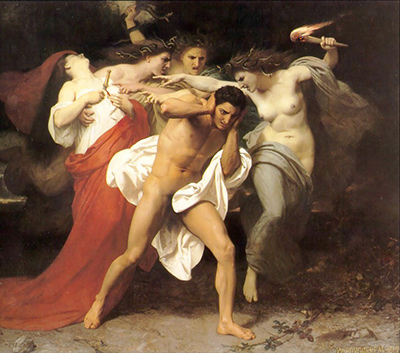The famous French painter and Great Master, William Bouguereau, painted Orestes Pursued by the Furies in 1862. The painting is also fondly referred to in the art world as The Remorse of Orestes.
The image in this epic painting is taken from a legend within Greek mythology, something which Bouguereau returned to again and again in his art, as many of his paintings were inspired by Greek legends.
What we observe when we consider this painting, is the terrified figure of Orestes, who is being belittled, tormented and humiliated by the Furies. Taken from Greek tragedy, the mythical and powerful goddesses descend upon Orestes in an act of vengeance. In the painting we observe three frightening Furies. One of whom holds a flaming touch above her head.
All have long flowing hair that seems to glow in the darkness of the image. We observe a cowering Orestes, covering his ears, while a white bed sheet protecting his modesty. To the left of him on the canvas is his mother, Clytemnestra, seemingly dead with a dagger protruding menacingly from her heart. Greek legend states that Orestes killed his mother and that the mythical Furies descried to Earth to punish him for his crime.
The sheer scale of this oil on canvas painting draws the eye to the centre of the image, and the shrinking figure of Orestes, making the observer feel great pity for him at his plight. The scene is incredibly realistic, painted in a natural composition which makes the horror of the scene even more apparent. We can only wonder at the emotions running through Orestes's mind, and wonder if the beautiful goddesses drove him to madness.
Bouguereau was an accomplished Grand Master of the French painting establishment, and many young aspiring artists followed in his path. However, the art critics of the day often stated that his art was melodramatic and too heavy in its tone. His work, and this painting, were shown at the Paris Show in 1863, but did not receive critical acclaim.




